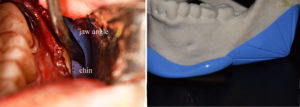While chin implants were the original jaw augmentation method, the development and emergence of jaw angle implants now provides an option for the rest of the jaw as well. The combination of standard chin and jaw angle implants can be done to create a total jawline enhancement. Placed at the three ‘corners’ of the jaw, such facial implants can provide improved skeletal definition of the entire lower third of the face.
One facet of using three standard but separate jaw implants is how they connect, or more accurately, do they have any overlap. While it is true that the part of the lower jaw between the three corners (body of the mandible) is not augmented per se, the posterior tail of the chin implant and the front edge of the jaw angle implant may or may not connect in the ‘middle’. Whether this occurs depends on the size of the jaw as well as that of the implants.

One side benefit to this overlap is how it can help position the jaw angle implants. In jaw angle implants the biggest positioning problem is getting their anteroposterior position correct and with good symmetry between the two sides. (usually not getting the implant back far enough to the angle) Since the chin implant has a fixed wing length, it can serve as a guide for where the jaw angle implants are placed. The overlap helps guide both the level of the jaw angle implant placement along the inferior border as well as where it sits in an anteroposterior location. (which is an important guide for implant symmetry)
Dr. Barry Eppley
Indianapolis, Indiana




